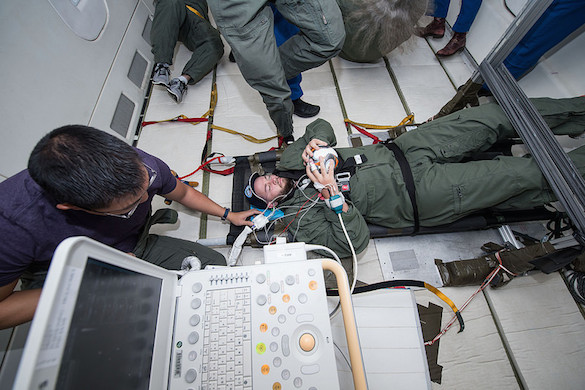Effects of Microgravity on Intracranial Pressure
PI: Benjamin Levine, University of Texas Southwestern Medical Center - Dallas, Douglas Hamilton (Co-I), Wyle Laboratories Inc.
PI: Benjamin Levine, University of Texas Southwestern Medical Center - Dallas, Douglas Hamilton (Co-I), Wyle Laboratories Inc.

- TA06 Human Health, Life Support and Habitation Systems
The current working model is that it may be related to changes in intracranial pressure (ICP) due to fluid shifts in zero gravity, perhaps exacerbated by small increases in the pCO2 or by exercise. However, only a few in-flight (ultrasound) and post-flight (MRI and lumbar puncture) observations support this contention. The only way to obtain this knowledge with certainty is to directly measure ICP during relevant changes in hydrostatic gradients. Importantly, these measures must be made in concert with an evaluation of inflow (arterial) and outflow (venous) pressures and flows to better understand intracranial hemodynamics in space. The primary objective of this application is to directly measure intracranial pressure, cerebral hemodynamics, and visual apparatus structure during changes in hydrostatic gradients (parabolic flight) that mimic microgravity exposure.
Only a careful dissection of the pathophysiology will allow the development of effective countermeasures that could ultimately lead to reducing the risk of visual impairment during space flight. Thus, this project will serve as the essential science base required to address a potential critical impediment to safe, long- duration space flight. NSBRI project funding began 10/1/2012.
NASA
To test these hypotheses, we will accomplish the following specific aims:
Specific Aim 1: We will recruit adult patients whom, because of prior medical treatment, have a brain access port from which ICP can be measured with little risk to the patient. Importantly, the selected patients will have no intracranial or cardiovascular pathology, and thus ICP can be measured accurately. Simultaneous measurement of RA pressure and blood pressure will be combined with ultrasound measures of the middle cerebral artery, carotid and jugular vessels, and ocular ultrasound for globe size, shape and optic sheath diameter. These measures will allow a comprehensive assessment of cerebrovascular hemodynamics during routine gravitational transients (upright and supine).
The hydrostatic indifference point will be determined in each volunteer. Additional measurements will be made with modest increases in carbon dioxide concentrations, and during strength exercise to determine the independent and additive effects of these confounding stimuli.
Specific Aim 2: After completion of the Aim 1 baseline studies in Dallas, subjects will be exposed to parabolic flight on a separate occasion to achieve brief periods of microgravity. This protocol will allow comparison between real microgravity, and usual terrestrial changes in hydrostatic gradients during daily life. Similar to aim 1, measurements will be obtained at rest, during exercise, and during small increases in carbon dioxide concentrations (10 parabolas each). The study of intracranial and cardiocerebral hemodynamics in microgravity has been largely unexplored. Only a careful dissection of the pathophysiology will allow the development of effective countermeasures that could ultimately lead to reducing the risk of visual impairment during space flight.
Technology Details
-
Selection DateAFO8 (Apr 2014)
-
Program StatusCompleted
- 2 Parabolic
Development Team
-
PIBenjamin Levine
-
PI Organization
-
Co-IDouglas Hamilton
-
Co-I Organization
-
SponsorNational Space Biomedical Research Institute (NSBRI)
-
PartnersSinai Hospital of Baltimore, Inc.
-
More Information

